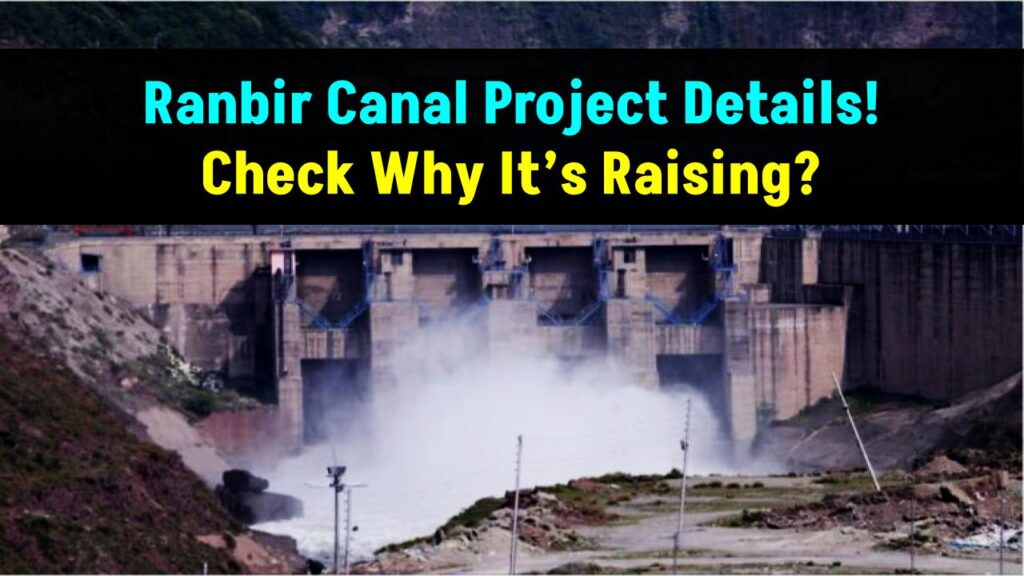Ranbir Canal Project Details: The Ranbir Canal Project in Jammu and Kashmir is drawing global attention as it becomes a focal point of rising tensions between India and Pakistan. With India planning a major expansion of the canal, which sources water from the Chenab River, concerns are escalating, particularly following India’s suspension of its participation in the Indus Waters Treaty. This article explores the background, current developments, and implications of the Ranbir Canal Project, offering clear insights for both general readers and professionals.

Ranbir Canal Project Details
| Aspect | Details |
|---|---|
| Project | Ranbir Canal Expansion in Jammu & Kashmir |
| Current Canal Length | Approx. 60 km |
| Proposed Expansion | Up to 120 km |
| Water Source | Chenab River (part of the Indus River system) |
| Current Flow Capacity | ~40 cubic meters/second |
| Proposed Flow Capacity | Up to 150 cubic meters/second |
| Impacted Treaty | Indus Waters Treaty, 1960 |
| Pakistan’s Dependency | 80% agriculture and energy relies on Indus system |
| Government Initiative | Desilting in Kathua, Ravi, Paragwal canals |
| Official Reference | India Water Portal, Reuters |
The Ranbir Canal Project is more than an infrastructure initiative—it represents a turning point in India-Pakistan relations and water diplomacy in South Asia. While India’s goals center around resource maximization and national security, Pakistan perceives it as a direct threat to its water sovereignty. As both nations navigate this turbulent phase, diplomacy and transparent communication will be key to avoiding conflict.
Understanding the Ranbir Canal: A Lifeline Turned Flashpoint
Constructed in 1905 during the reign of Maharaja Pratap Singh, the Ranbir Canal is an essential irrigation channel in the Jammu region. The canal, which originates from the Chenab River at Akhnoor, plays a vital role in supplying water to agricultural lands across the Jammu plains.
Historically, this canal helped transform the agrarian landscape of the region. Now, over a century later, India’s decision to expand it has stirred geopolitical anxieties, particularly in neighboring Pakistan.
India’s Canal Expansion Plans: National Development or Strategic Leverage?
The Government of India has proposed doubling the canal’s length to 120 km and tripling its water-carrying capacity. According to officials, the goal is to fully utilize India’s water rights under the Indus Waters Treaty (IWT). The plan involves:
- Expanding canal infrastructure
- Increasing irrigation coverage
- Enhancing agricultural productivity
- Boosting water use from the Chenab River, which was previously underutilized
This initiative follows India’s withdrawal from the IWT in 2023, a decision linked to heightened tensions after a terrorist attack in Pahalgam, which Indian authorities blamed on Pakistan
Additionally, desilting and modernizing other regional canals in Kathua, Ravi, and Paragwal have been launched to complement the canal upgrade (Uday India).
Why Is Pakistan Worried About the Ranbir Canal Project?
Pakistan’s alarm is rooted in water security. The Indus River system supplies more than 80% of Pakistan’s agricultural and hydropower needs. Any upstream diversion by India could impact downstream availability.
While the Indus Waters Treaty allowed India to use waters from eastern rivers (Ravi, Beas, Sutlej), it imposed restrictions on western rivers (Indus, Jhelum, Chenab) allocated to Pakistan.
With India now seeking maximum utilization of the Chenab, Islamabad views the Ranbir Canal expansion as a potential treaty violation, despite India arguing otherwise. Pakistani officials have:
- Threatened legal action in international forums
- Called the move an “act of war”
- Sought diplomatic support from China and other allies
Regional and Global Implications: A Water War in the Making?
The Indus Waters Treaty, brokered by the World Bank in 1960, has stood the test of three wars between India and Pakistan. It is often cited as a success story in transboundary water management.
However, the current developments may destabilize regional peace:
- Strategic Use of Water: India using water as leverage in response to terrorism is a shift from prior restraint.
- China’s Role: China, too, controls upstream waters of the Brahmaputra and could retaliate if regional water conflicts rise.
- Environmental Impact: Massive canal expansion may alter local ecology and affect river biodiversity.
Experts warn that geopolitical use of water resources could push the subcontinent toward new forms of conflict.
“Weaponizing water poses a grave threat to South Asia’s fragile peace,” says water diplomacy expert Dr. Rajiv Sharma.
Practical Insights: What This Means for Locals and Farmers
If implemented effectively, the Ranbir Canal expansion could transform Jammu’s agricultural economy:
- More irrigated land = better crop yield
- Year-round water availability
- Job creation via construction and canal maintenance
Yet, challenges remain:
- Delays in execution due to political tension
- Risk of international sanctions or litigation
- Maintenance of ecological balance in the Chenab basin
FAQs on Ranbir Canal Project Details
What is the Ranbir Canal?
It is an irrigation canal built in 1905, sourcing water from the Chenab River in Jammu and Kashmir.
Why is its expansion controversial?
India’s plan to increase water extraction from a river largely allocated to Pakistan under the Indus Waters Treaty is seen as provocative by Islamabad.
How will this affect farmers?
If completed, the project could improve irrigation and boost agricultural output in Jammu.
Is India violating the Indus Waters Treaty?
India claims it is utilizing its rightful share. Pakistan disputes this, calling it a breach of international agreement.
What are the possible outcomes?
Potential scenarios include legal arbitration, diplomatic standoff, or military escalation depending on future political dynamics.





